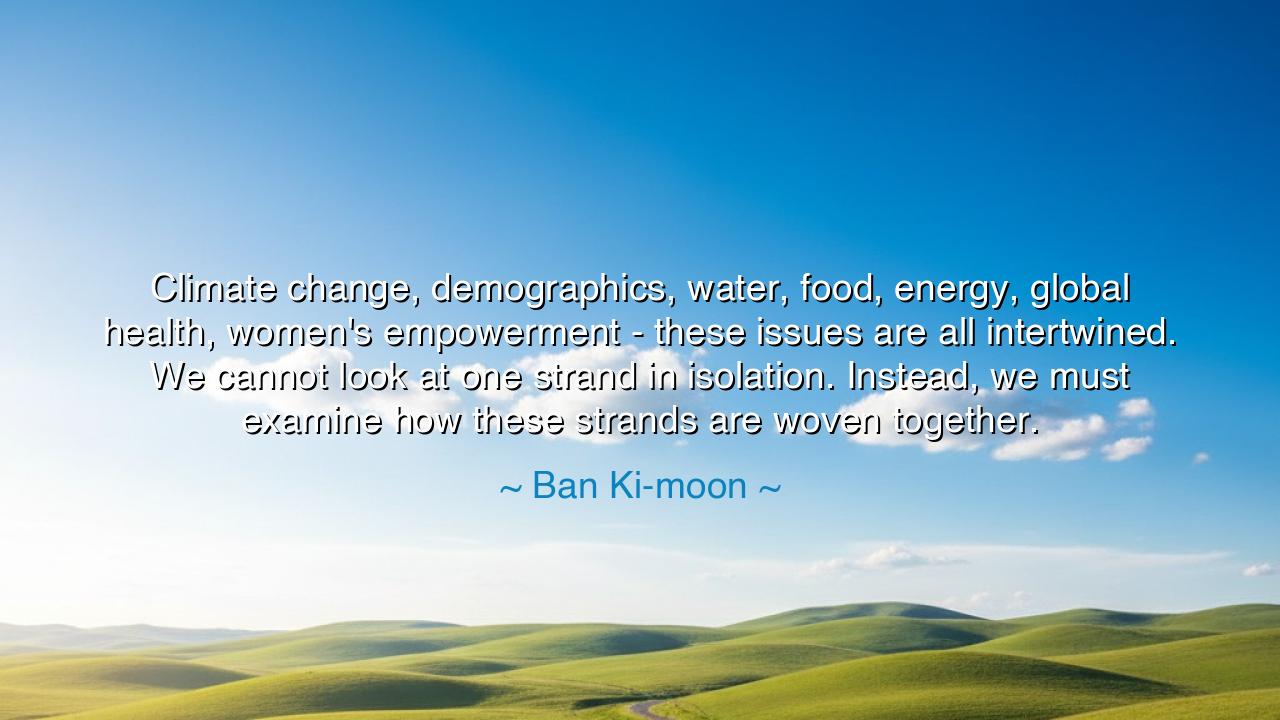
Climate change, demographics, water, food, energy, global health
Climate change, demographics, water, food, energy, global health, women's empowerment - these issues are all intertwined. We cannot look at one strand in isolation. Instead, we must examine how these strands are woven together.






There are words that rise above politics and echo through the corridors of time — words that call upon humanity not merely to act, but to understand its unity. Such are the words of Ban Ki-moon, who spoke as both a witness and a guardian of the Earth: “Climate change, demographics, water, food, energy, global health, women’s empowerment — these issues are all intertwined. We cannot look at one strand in isolation. Instead, we must examine how these strands are woven together.” In this vision, we hear the wisdom of the ancients reborn — the call to see not the parts, but the whole. For all things that live and breathe are bound by invisible threads, and when one is pulled, the rest trembles.
In the age of old, wise men and women understood this truth instinctively. The farmer knew that the rain, the soil, and the sun were not separate blessings, but one harmony. The healer saw that the health of a person was tied to the health of their village, the cleanliness of their water, and the peace in their heart. But as the centuries unfolded and the world grew complex with its own inventions, humankind began to forget this unity. Nations built walls of specialization — one tending to economy, another to energy, another to health — and in doing so, they lost sight of the great tapestry of life. Ban Ki-moon’s words come as a reminder to awaken from this forgetfulness, to once again behold the interwoven nature of existence.
Consider the story of the Aral Sea, once a vast inland ocean shared by Central Asian peoples. In pursuit of progress, the rivers that fed it were diverted to grow cotton. For a time, the fields flourished — wealth and trade bloomed. Yet the water receded, the air turned to dust, and disease spread where prosperity once stood. The people had solved one problem — food and commerce — but ignored the others — climate, water, health. Thus, the Sea became a desert, and the lesson became clear: when we tend one thread of the web and neglect the rest, the whole fabric unravels.
Ban Ki-moon, as the Secretary-General of the United Nations, had seen such unraveling across the world — in floods that devoured nations, in wars over rivers, in hunger born not of scarcity, but of imbalance. His insight was forged not in comfort, but in witnessing the suffering of millions. He knew that climate change was not a distant threat, but a mirror reflecting all our choices. It alters food through drought, health through disease, energy through scarcity, and even gender equality, for it is often women who bear the burden when the Earth is wounded. In this truth, his voice becomes that of a teacher from ages past: reminding us that no issue stands alone — every struggle of humanity is a reflection of its relationship to nature and to itself.
This understanding calls for wisdom over haste, cooperation over division, and vision over convenience. Just as no thread can form a fabric alone, no nation, no policy, no movement can solve these challenges in isolation. The call is for unity — a unity of thought, of purpose, of compassion. The environmentalist must walk beside the economist, the scientist beside the farmer, the leader beside the citizen. Only when we weave these threads together can the tapestry of the Earth be mended and strengthened.
There is also a spiritual depth in Ban Ki-moon’s teaching. It reminds us that the Earth is not merely a collection of resources, but a living body — and we are its cells. To poison one part is to endanger the whole. To heal the planet, we must heal ourselves — our greed, our blindness, our habit of separation. The rivers are not apart from us; they flow through us. The forests do not merely surround us; they breathe with us. The empowerment of women is not a separate struggle from the health of nations — it is the same struggle, for life itself is feminine in its giving, nurturing nature.
And so, the lesson is both humble and grand: see the connections. When you act, think not of the moment alone, but of the web your choice touches. In your daily life, let your awareness be like a wide sky — consider where your food comes from, how your energy is made, who labors unseen for your comfort. Support what sustains rather than exploits; listen to those who speak for the silenced. For the world is a loom, and every hand that works upon it shapes the future.
Let Ban Ki-moon’s words ring in your heart as both warning and promise: “We must examine how these strands are woven together.” For to weave wisely is to ensure that our children inherit not a tattered world, but a garment strong enough to shelter them. This is the task of our age — to restore harmony to the broken web, to remember once more that we are not the masters of creation, but its stewards. Only then shall we be worthy of the life we have been given, and of the planet that sustains it.






AAdministratorAdministrator
Welcome, honored guests. Please leave a comment, we will respond soon